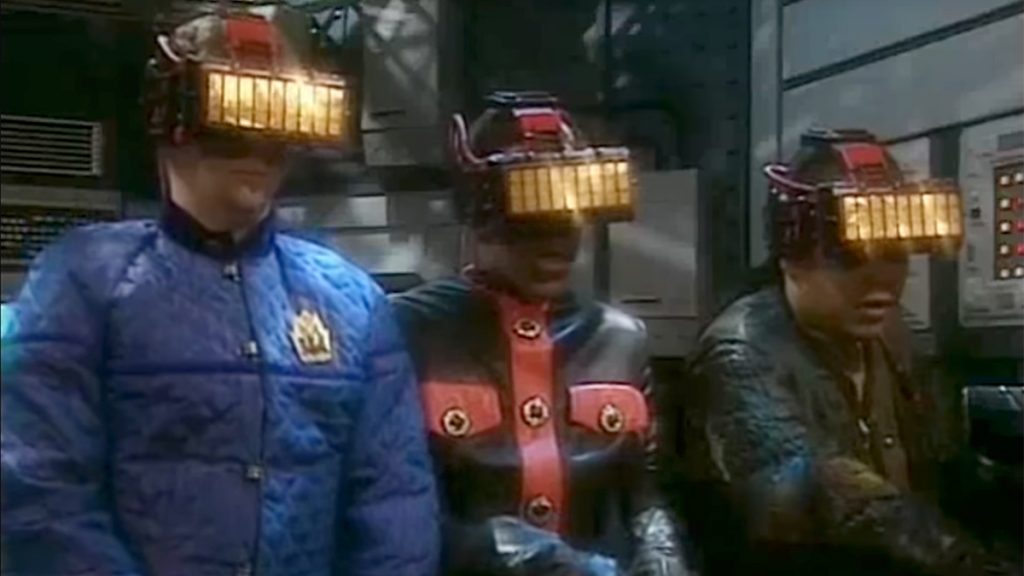Core Data:
- Vision: Total Immersion Videogames
- Type: Popular culture – TV
- As Seen In: Red Dwarf (‘Better Than Life’ (also a novel), ‘Back To Reality’, ‘Gunmen Of The Apocalypse’, ‘Stoke Me A Clipper’)
- Envisioned: 1988-1997, and beyond
- Visionaries: Rob Grant, Doug Naylor
- Target Date: Three million years in the future
Overview:
Where Star Trek tends to favour the holodeck, Red Dwarf is much more partial to passing the time in virtual reality simulations. In storytelling terms, both scenarios perform a similar function – they’re an excuse to get the respective crews outside the confines of a spaceship – but Red Dwarf’s tech seems rather more plausible than the borderline magic of The Next Generation.
For starters, the fact that the machinery is primarily built for gaming and leisure seems entirely consistent with what we know in the modern world. Then there’s the artificial reality headsets, which closely resemble devices readily available in the 21st century. Yes, the idea of projecting our heart’s desires directly into our neural cortexes remains far-fetched, but it’s not as out-there as a room that can use light to create three-dimensional, tactile simulations indistinguishable from reality.
As far back as its second series in 1988, the long-running UK sitcom has been dabbling with virtual reality gaming. And from ‘Better Than Life’ to ‘Back To Reality’ and the Emmy-winning ‘Gunmen Of The Apocalypse’, Red Dwarf’s adventures in cyberspace have led to some of the show’s most beloved episodes.
Not bad for tech that’s traditionally been constrained by the meagre production budgets of 1980s/’90s British sci-fi TV…
Key Tenets:
- Experience: Total Immersion Videogames transport the user to a virtual reality simulation indistinguishable from real life.
- The popular Better Than Life game is able to detect a user’s fantasies and desires, and make them come true. (As seen in Red Dwarf II episode ‘Better Than Life’.)
- Although the game promises an experience that’s, well, better than life, the device is also prone to playing out nightmarish scenarios if the player logs in with overly negative emotions. This can also affect the enjoyment of fellow participants.
- Other Total Immersion Videogames enable the player to take part in pre-loaded scenarios. In series five episode ‘Back To Reality’, for example, it’s possible to spend years playing a TIV called Red Dwarf, where participants take on the roles of crew members Dave Lister, Arnold Rimmer, Kryten and the Cat. The experience is so all-encompassing that players suffer from amnesia when the game is over. (Though it should be noted that the game doesn’t really exist, even in the Red Dwarf universe – it’s actually the hyper-real creation of a Despair Squid-induced hallucination.)
- The Boys from the Dwarf also use similar – though less invasive – Artificial Reality technology in series six episode ‘Gunmen Of The Apocalypse’, series seven outing ‘Stoke Me A Clipper’, and several subsequent episodes of the long-running sitcom.
- The AR system is dangerously susceptible to computer viruses.
- Hardware: The ‘Better Than Life’ hardware consists of headgear (essentially a bicycle helmet) that inserts sharp, pointy electrodes into the user’s frontal lobes and hypothalamus. These have the dual function of detecting the player’s desires, and simulating a new reality in their brain.
- The shock of removing the headset forcibly can kill a Better Than Life user.
- The ‘Back To Reality’ hardware also functions as a life-support system. As well as delivering the Red Dwarf game into the player’s mind, it delivers intravenous nutrition and removes bodily waste.
- The AR tech in ‘Gunmen Of The Apocalypse’ consists of a Daft Punk-like headset covering the eyes, while gloves allow the participant to interact with the game – a tap on the palm of the glove can be used to exit.
- Players’ movements in the real world mirror their actions in the game – this can look hilarious to any bystanders looking on.
- In ‘Stoke Me A Clipper’, Starbug is home to an Artificial Reality Suite. The sit-down apparatus features an all-over headset and a groinal attachment for more adult activities.
- Economics: The Back To Reality unit used by the Red Dwarf crew arrives in a long-delayed mailpod from Earth, so cost isn’t really an issue – good news, seeing as three-million years’ worth of inflation isn’t going to help the bank balance. We do know, however, that in the late 22nd century, the game was a smash hit across the Solar System, suggesting it retailed at a reasonable price.
- The ‘Back To Reality’ game, meanwhile, has a two-year waiting list for its 20, four-person gaming units. Going on the lack of availability – and the fact the Red Dwarf crew have supposedly been playing for four years – it’s safe to assume that the business model requires tickets to change hands at a very high price.
- IP: While Better Than Life’s USP is its ability to tap into a player’s own desires – negating the need for original stories – the AR tech features its own games. These include crime noir Gumshoe, Western sim Streets Of Laredo, tennis game Wimbledon, Zero-G Kickboxing and a recreation of medieval England.
- Company: Gumshoe and Streets Of Laredo are created by Interstella Action Games.

State of Play (October 2021)
- Experience: While numerous medical technologies (such as EEGs and MRIs) can be used to monitor brain activity, translating these electrical signals into coherent sounds and images is currently beyond our capabilities.
- Signing your life away for several years of total immersion gaming – with all your nutrition needs taken care of – is also not an option at present. Though if the tech did suddenly become available, you can guarantee there’d be plenty of gamers eager to sign up.
- Hardware: Although present-day neural interfaces are capable of delivering simple commands to control computers and games, we can’t use them to deliver simulations directly into a user’s brain in the manner of a Better Than Life headset.
- Devices like the Oculus Quest 2 have shown that immersive, 3D videogaming is entirely feasible – simulations may not look quite as photo-real as Red Dwarf’s at present, but that’s surely a matter of time.
- Instead of the gloves used in Red Dwarf’s AR tech, systems like Oculus’s usually have handsets that perform a similar function.
- Haptic gloves can already be used to replicate the sensation of touch.
- Economics: Screen-based gaming (whether on television, desktop or mobile) remain the most popular option for gamers, but immersive VR headsets are becoming more sophisticated and reasonably priced. Whether they become the standard for gaming, however, remains to be seen.
- Companies: In addition to Oculus, Sony PlayStation, HTC, Pico Interactive and Livemap are all working with virtual reality headsets.

Reality Check: Mostly Plausible
While we’re not quite at the stage of creating fully interactive, photoreal artificial reality simulations for mass consumption, the headsets and interfaces of the AR devices in ‘Gunmen Of The Apocalypse’ are remarkably similar to modern tech – it’s surely only a matter of time before reality catches up with the sci-fi.
It’s safe to say, however, that we’ll be waiting significantly longer for Total Immersion Videogames delivered directly to the brain, and 24/7 games with built-in life support.
Further Reference:
- Red Dwarf: ‘Better Than Life’ (TV episode)
- Red Dwarf: ‘Better Than Life’ (novel)
- Red Dwarf: ‘Back To Reality’ (TV episode)
- Red Dwarf: ‘Gunmen Of The Apocalypse’ (TV episode)
- Red Dwarf: ‘Stoke Me A Clipper’ (TV episode)
- Metaverse
- Virtual reality
A self-confessed full-time geek, freelance journalist Richard has spent most of his career writing about sci-fi and fantasy – including more than a decade on staff for SFX magazine. He's particularly keen on franchises with "Star" in the title.



































